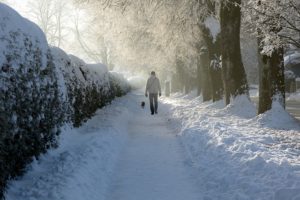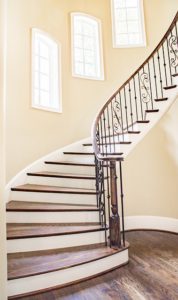Over the past couple of years, I’ve discovered a new Murphy’s Law. It’s this: The older you are, the worse the outcome tends to be when you fall. Three years ago, I slipped on a patch of snow-dusted ice and broke my elbow. And three weeks ago, I stepped out the front door and fell. It was early in the morning and went out to walk the dog, unaware that we had gotten freezing rain overnight. It was still dark, and I didn’t think twice about the sidewalk because it had been completely clear and dry the night before. My first step out the door took me down, and I landed on the middle of my back. Hard. The good news was that I didn’t hit my head, but the bad news was that I knew I was hurt. An early morning trip to the Emergency Room confirmed that I had fractured a vertebrae in my mid-back. This kind of fracture is a bit like broken ribs; you just have to manage the pain and let it heal. So armed with pain meds, a far-infrared heating pad, A TENS unit and lidocaine patches, I’ve been getting through it.
When it comes to falls, it seems the conversation always turns to the elderly, which is fair because while people of all ages fall and can get hurt, older people break more easily when they go down. That said, both of my falls were righteous hits, no matter my age. Three years ago, as I was being wheeled into the operating room to repair my broken elbow, the 40ish anesthesiologist said to me, “Bummer! I did the exact same thing when I was in high school.” And as I was sitting in the ER after this last fall, I sat next to young people who had also fallen on the ice that morning and broken bones.
So when I talk about fall prevention, I’m speaking to people of all ages while acknowledging that older people may be more prone to falls and fare less well than those who are younger. And with my history I feel like I have some experience when it comes to falls. Here’s my best advice on how to prevent them:
-Don’t get distracted let your guard down, and don’t walk and look at your phone at the same time. Pay attention, especially on sketchy surfaces,  such as snow and ice and those that are uneven, freshly polished, greasy or wet. Had I taken a look at the sidewalk before I stepped out onto the ice, I would have avoided a world of pain, but my mind was on other things.
such as snow and ice and those that are uneven, freshly polished, greasy or wet. Had I taken a look at the sidewalk before I stepped out onto the ice, I would have avoided a world of pain, but my mind was on other things.
-Anticipate opportunities for falling and do what you can to offset them. If you live where it freezes in the winter, know that ice or snow is always a hazard and throw down some ice melting agent, kitty litter or sand to improve traction. If you’re navigating a narrow or steep stairway, make sure the light is on and grab the handrail, and go slowly and carefully on sloped or uneven surfaces, such as ramps and sidewalks.
-Reduce risks in your personal space. A great deal of falls occur in and around your home (like me, right off the front step). The good news is that there’s a lot you can do to make your space safer. Reduce the floor clutter in your house, make sure there are no loose rugs or cords that can take you down, and wipe up food and liquid spills in the kitchen. When I was a kid, a single green pea on the kitchen floor took my sister down, resulting in a sprained ankle. Really, it doesn’t take much.
-Your footwear makes a difference, too. Both of my falls could have been avoided had I been wearing ice biters (they’re like thick rubber bands with cleats or coils that attach to the bottom of your shoes). I only buy walking shoes that have no-slip Vibram soles, and after this last fall, I ordered boots with built in ice grippers that lock into place when I need them. If you’re prone to turning your ankles, walking shoes that come up over your ankles can also help decrease your risk.
-Let’s talk about ladders. They’re a great tool, until they’re not. It seems that I’m always hearing about some poor soul who fell off a ladder and broke bones, hit their head or worse. If you simply must get up on a ladder, make sure the base is on a level surface where it won’t slip or move. Don’t do it solo; make sure you have someone to hold the base of the ladder steady and spot you as you go up and come down. And for Heaven’s sake, have the wisdom to know when you should call a professional to get up on your roof or into that tree with a broken branch. It could save you a world of hurt.
broke bones, hit their head or worse. If you simply must get up on a ladder, make sure the base is on a level surface where it won’t slip or move. Don’t do it solo; make sure you have someone to hold the base of the ladder steady and spot you as you go up and come down. And for Heaven’s sake, have the wisdom to know when you should call a professional to get up on your roof or into that tree with a broken branch. It could save you a world of hurt.
-Think of the dark as a hazard all on its own. Whether you’re getting up in the middle of the night or walking the dog in the dark, the absence of light means that there are many hazards that you won’t see. This includes area rugs, items left on your floor, furniture, uneven surfaces and even your pet. Fixing this is as easy as using the flashlight feature on your phone, adding a nightlight and the awareness that you won’t see what’s going to trip you up in the dark.
 -Don’t be too proud to use handrail, whether it’s on the stairs, in your bathroom or anywhere else. Think of handrails as a secret message that you’re entering a higher risk fall zone.
-Don’t be too proud to use handrail, whether it’s on the stairs, in your bathroom or anywhere else. Think of handrails as a secret message that you’re entering a higher risk fall zone.
-Pets can also take you off your feet in a number of ways. They can get underfoot at home, your dog pulling on its leash or simply having to go out and walk Fido on slippery days when you’d normally hunker down indoors. E.g., yours truly at 5 am in the dark after a night of freezing rain—something I would never do if it weren’t for the dog!
-If your balance is sub-par, your risk for falls in greatly increased, but there are ways to improve it. Your balance is controlled through your vestibular system (in your inner ear), your vision and proprioception (your sense of where you are in space) all working together. If you have serious balance problems or vertigo, you can work with a doctor or physical therapist who specializes in dizziness and balance issues. However, a simple fix to strengthen so-so balance is to stand on one foot (with a chair, wall or countertop nearby if needed for support). Begin with ten seconds balancing on each foot, working up to 30 seconds and then a minute.
-Finally, keep your cell phone with you when you’re out walking, and nearby when you’re at home. Both times I fell, I was lucky enough to have my phone in my pocket and was able to call a family member to help me. It has now become a personal rule, even when I’m just taking the dog out for a very quick trip.
The bottom line is that falls happen. I have been vigilant all winter, assessing the snow and ice in my neighborhood. However, all it takes is one second of letting your guard down at the wrong time and in the wrong place. The good news is that there some pretty simple things you can do to increase your awareness and lower your risk. Take it from me; an expert on falling!




Two comments. First, about 10 years ago , while walking from my truck to the bus stop on an early winter morn I
slipped backwards on black ice. First my butt and then the back of my head. Saw that flash of light. I worried all day at work that I would be the next Natasha Richardson (Liam Neeson’s wife). In 2009, she sustained a head injury when she fell while skiing . At first, she refused any medical help but complained of a severe headache about two hours after the accident. She died two days later from an epidural hematoma. I worried that it’s possible that you don’t die right away but later when you think you’re OK. Second how can you blame sweet Stewie?
You make a good point. While I didn’t hit my head, I knew immediately that I needed medical help. When a fall involves a head injury, I highly recommend getting it checked out, as the fallout from hitting your head can take some time, but can be deadly. As for Stewie the dog, I’m happy to walk him, rain or shine, but if I weren’t a dog owner it’s unlikely I’d be caught off guard on the ice at 5 a.m. in the morning!